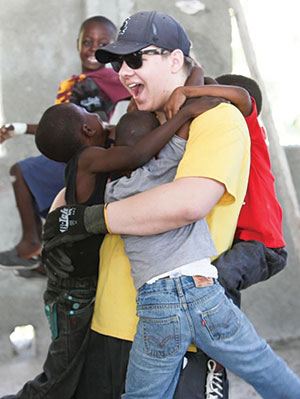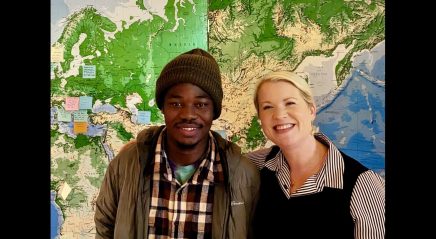Service to others is a key practice of discipleship. Many churches organize service (or mission) trips as an eye-opening way to put faith into action. These independently organized “volunteer vacations” are growing in popularity. How can we make sure our efforts are effective?
I was 13 when I traveled to eastern Washington with my church youth group on a service trip for Habitat for Humanity. Joining up with 100 or so other youth, we built both homes and friendships.
The experience was transformative, opening my eyes to realities beyond my own. Economic injustice now had faces — and those faces had become my friends. The youth leaders I got to know during that week became role models of faith in action. The week had a major impact on my eventual education and career in international development.
When I reflect on why my first service trip had such an impact, there are four key aspects.

Michael Peterson, a member of Our Saviour Lutheran Church, Naperville, Ill., connects with local children while on a recent mission trip to Haiti.
Doing vs. donating
Would it be better just to send the money? The truth is, we aren’t usually choosing between a service trip and a donation. We want to travel, and we’re choosing what kind of experience we want for ourselves (or for our youth). As the adage says: “Tell me and I forget, teach me and I may remember, involve me and I learn.”
How can we have compassion for others if we don’t know their situation? It’s wonderful to assist at home, but traveling to serve presents another experience beyond our upbringings and surroundings. Putting effort into addressing an issue, we better understand the challenges.
Learning and exchange
A key component of an effective service trip is learning and exchange.
By reading and watching videos about the destination and its people while still at home, volunteers become better equipped to understand and process the reality they encounter when they arrive. Education about the destination’s culture, concerns and context should be integrated into the trip.
Understanding can’t occur if we keep people at arm’s length. Yes, getting to know someone different from ourselves isn’t always easy or comfortable. It’s tempting to fall into the trap of socializing only with those in our service group. But how then will we get to know and understand cultural assumptions and worldviews that differ from our own? How will we learn which concerns and joys we share? Sometimes it takes a conscious effort to strike up conversations and friendships with the community in which we serve.
A family our youth group served had teenagers who became my friends. The experience was richer because of this. Which brings me to my next point.

Photo by Lori Prater
Holden Kohlmeyer and Mia and Anya Prater, members of Atonement Lutheran Church, Boulder, Colo., prep a house for painting in Green River, Utah, while on a mission trip. They also replaced leaking windowpanes on the house as part of Atonement’s partnership with the Epicenter’s Fix It First program.
Accompaniment
The organization I first volunteered with, Habitat for Humanity, treats its housing beneficiaries as equals and requires their involvement (they call it “sweat equity”) into the construction of a home. It’s truly a shoulder-to-shoulder experience, a partnership between volunteer and beneficiary.
The idea of accompaniment rather than sponsorship is an important ELCA method expressed in the values of mutuality, inclusiveness, etc.
“As the ELCA, we find that it’s not that one partner has the resources and one partner has the need. We come together in mutual need,” said Ryan Cumming, program director for hunger education with the ELCA.
It’s a method of mission practiced by ELCA missionaries and is a good model to follow for any type of service work.
Service is faith in action
As a regular churchgoer, I witnessed pastors and laypeople living out their faith every week. But what resonates — especially with young people — is watching adults hammering a nail or standing in solidarity with others. Leaders can impart an important lesson in discipleship without saying a word.
Volunteering with a faith-based organization doesn’t guarantee a faith experience — so intentionality may be up to you. Although Habitat is Christian-based, we didn’t recite prayers as we installed drywall. But we did take time each evening to reflect on the day’s experience — our own role in it and God’s hand in all of it.
Even if volunteering with a secular organization, don’t miss opportunities to discuss how our work is God’s work. Explore larger issues that created the need in the first place, and how individual and government choices and policies impact those issues. Through it all, pray for God’s guidance in serving.
Four ways to deepen your impact
Prepare. Read up on your destination and its people in
advance to better understand the context when you arrive.
Spend locally. Seek out locally owned accommodations and restaurants, even for snacks.
Spark connections with others inside and outside of your service project. Introduce your team to a local group, serve alongside a local congregation. Consider homestays instead of a hotel. Attend an area worship service, concert or community event. Find a theological voice from your destination and engage.
Bring it home. Share your experience at church, write an
article in your school newsletter, or offer a brown bag lunch at your office. Write a blog. Make a video about your trip. Set a goal to continue your service at home, such as one project a month. Contact area politicians to advocate for policies that will help address the issue your service work supported.







